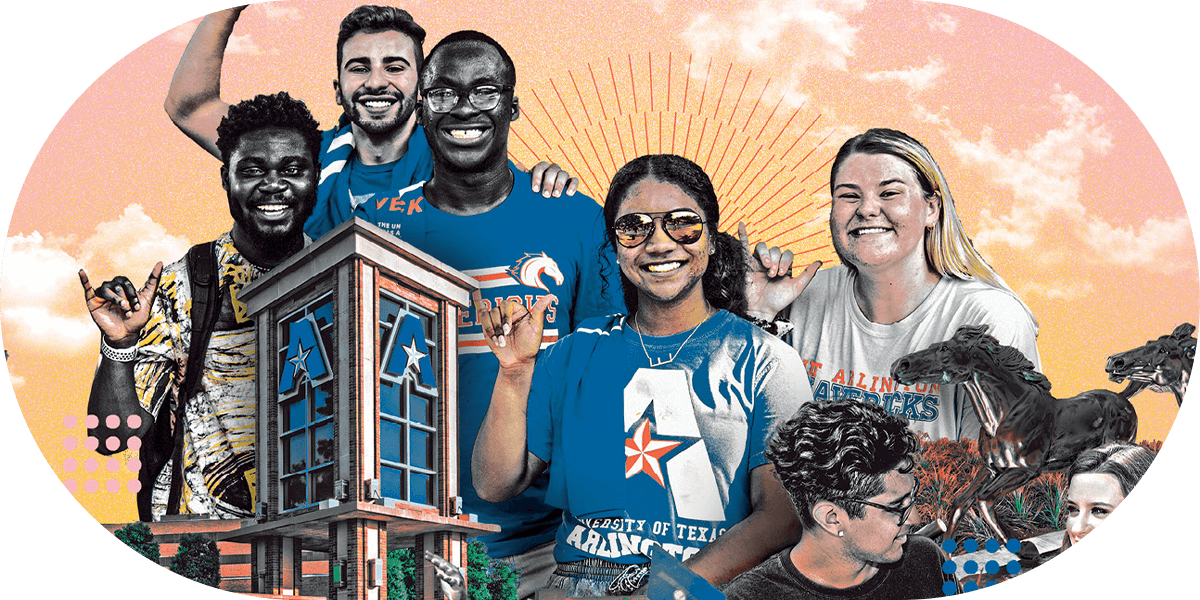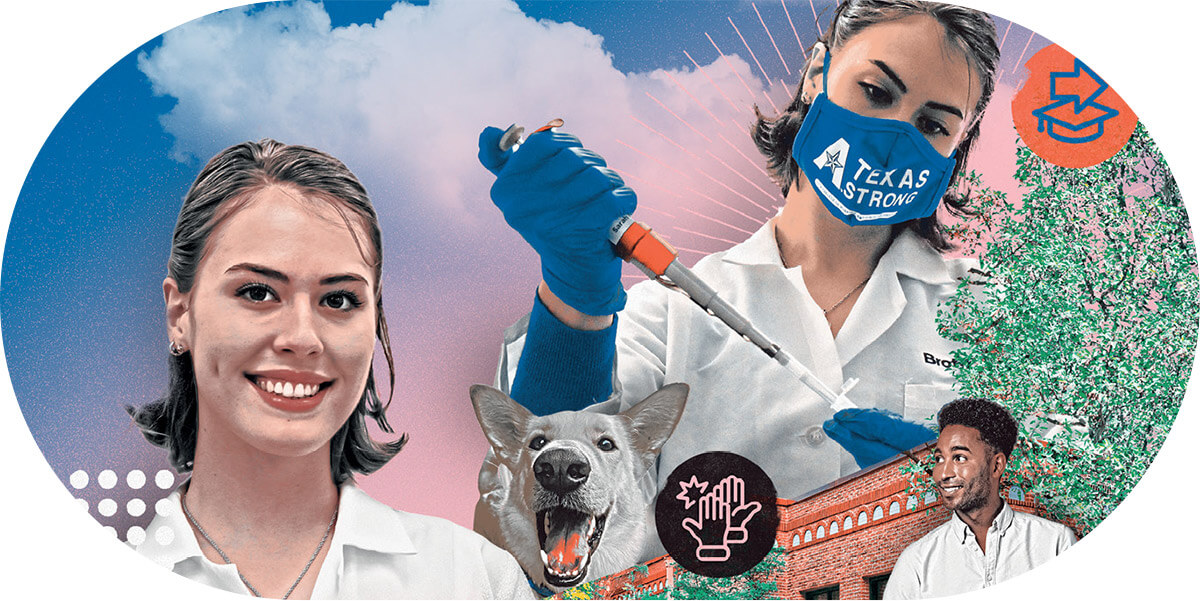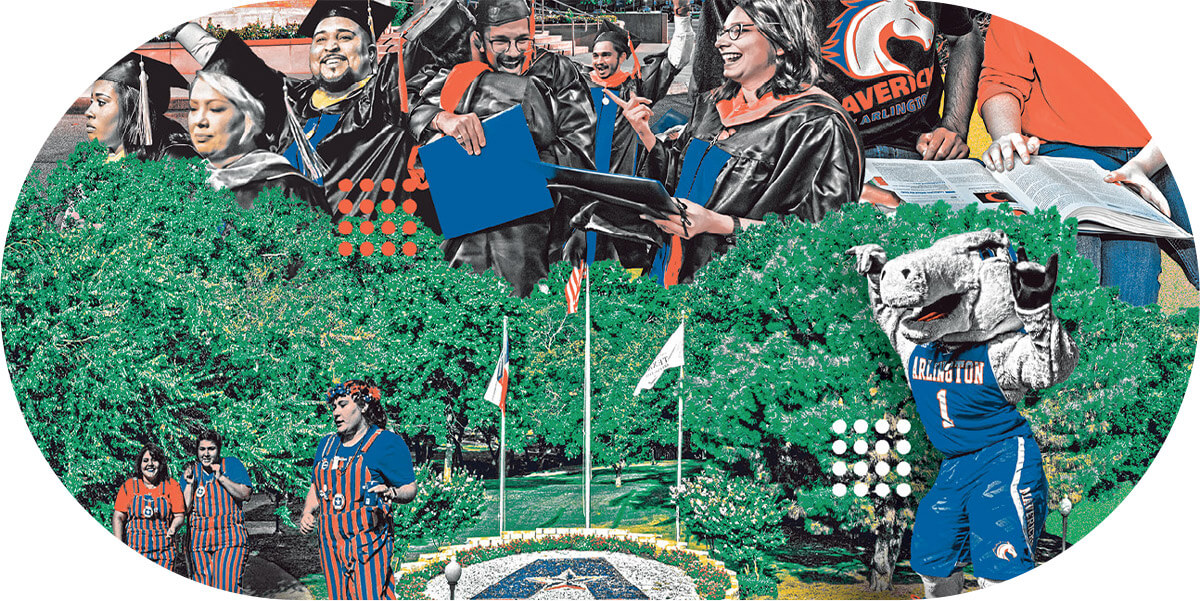
Nursing student Sarah Nelson jokes that her dog Faben knows a lot about insulin right now. When studying, Nelson turns to her German shepherd husky mix and teaches him as if he were a student, helping cement the information in her mind before tests. It’s a trick she learned thanks to UTA, and it’s one of several study techniques that propelled her to higher grades, greater confidence, and an even brighter future. She teaches these tips to fellow students so they can find their own paths to academic success.

Students like Sarah Nelson, pictured here along with her dog and study buddy, Faben, benefit from programs in the Division of Student Success— and in turn are often inspired to give back, supporting the success of their peers.
“It’s probably the most impactful thing I have done in my life so far,” says Nelson, who leads study sessions for students as a supplemental instruction (SI) leader. “I know college can be very difficult ... and if I can be that one resource that makes it a little bit easier, then my job is done, and I am happy and fulfilled.”
UTA supports its students’ academic success through a holistic approach that includes academic advising and coaching, tutoring, supplemental instruction (SI), peer-led team learning, residential learning communities, first-year experience courses, and more. Most of these services are housed in UTA’s Division of Student Success, founded in 2018, where Nelson is an SI leader. Scholarships and fellowships also play a key role in giving talented, highly motivated students the financial assistance they need to complete school, empowering them to succeed in college and careers.
“We want to help students early in their academic careers to develop a plan for success that is unique to them as individuals and their hopes and dreams,” says Ashley Purgason, associate vice provost for the division. “We want students to develop a sense of belonging, to acquire a strong affinity for the institution, and, for their own motivation, to complete their degree. The way we do that is by helping them see success in themselves very early on in the process.”
STARTING OUT
That educational journey often starts with an academic advisor from the division’s University Advising Center (UAC), which primarily serves first-year, first-time-in-college students. Advisors are typically one of the first contacts that students make at UTA, says Aaron Brown, assistant vice provost for academic advising.
“We offer a friendly, knowledgeable presence at this institution,” Dr. Brown says. “We create a feeling of belonging and comfort for students. Knowing you have someone you can count on who is quick to listen and steer you in the right direction is huge.”
In 2020, the UAC held a whopping 17,750 appointments with students in person, by phone, through email, or virtually. In addition to academic advising, UAC advisors point students to help within UTA.
“Our advisors are trained to know the ins and outs of the University,” Brown says. “We offer tools and resources and referrals. When you put all that together, you can see how important that first academic advisor can be to get students merged onto the right path for their educational goals.”
Division of Student Success administrators say they want students to find resources early so they start strong. This summer, the division offered incoming students a program called Success U—virtual sessions to prepare for college after a year of possible learning loss during the pandemic. Students who completed the program earned a $350 Provost’s Award.
Freshmen take a first-year experience course to introduce them to UTA resources, friends, and an upper-class peer academic leader (PAL) who is trained by the division.
“We create a feeling of belonging and comfort for students. Knowing you have someone you can count on who is quick to listen and steer you in the right direction is huge.”
“You don’t feel alone, and that is really great,” says Alexandra Saucedo, a junior from Dallas studying public relations who took the course in 2020 and became a PAL this fall.
As a PAL, Saucedo works with a faculty member to develop and present lessons to 20 to 25 freshmen on topics from managing money to finding scholarships and improving study skills.
“Even if you don’t need it at the moment, it’s just good to know it up front your first year and fall back on it,” Saucedo says. “There’s a huge team there to help you.”
SUSTAINING SUCCESS
Whether students want to raise a grade or maintain an A, UTA’s resources can give them a scholarly edge. Academic coaches can create individualized plans to help with study skills, time management, and more.
“This isn’t just for students who are really struggling, although it could certainly help those students as well. But it could be for students who have maybe one poor exam grade or course in particular they are struggling with or one bad semester,” Dr. Purgason says. “Typically, all students have some point in their academic career when they struggle. We want students to realize that’s normal, and it’s OK. It’s not a reason to stop their education.”
Other initiatives focus on individual courses. Students such as Nelson,who graduated in December with honors, successfully complete a course for credit and then are hired as SI leaders to attend the course again and help others. Nelson held free study sessions as an SI leader for students in Anatomy and Physiology 1 and other nursing courses.
“I can’t even describe the swells of pride I feel,” Nelson says of seeing fellow students improve grades after attending study sessions.
Daisy Figueroa, a junior from Houston studying computer engineering, found help from SI leaders and TRIO, a federally funded program for eligible students.
“They made my life easier for my classes,” says Figueroa, who studied in South Korea in fall 2021. “In class, I’m more focused on taking notes than asking questions about the topic. Having that one-on-one with a tutor helps me ask questions and go over topics that I didn’t understand in class. ... The tutors will try many different ways to explain the topic to you to make sure you understand.”
INVESTING IN FUTURES
Scholarships are another way UTA helps support student success. UTA is pledging an additional $25 million in scholarships over the next five years to help academically talented students succeed.
Figueroa earned the Shirlee J. and Taylor Gandy First Generation Scholarship and Rear Admiral Grace M. Hopper STEM Scholarship, which not only helped make college more affordable, but also provided her with additional motivation to see her goals through to the end.
This is precisely the intention of the Gandy scholarship, which was established in 2012 to help first-generation students like Figueroa achieve academic success and set them up for bright futures after college. Shirlee Gandy (’70 BA, Political Science) was the first in her family to graduate from college, and she and her husband wanted to allow future generations of Mavericks the same opportunity.
Likewise, the Rear Admiral Grace M. Hopper STEM Scholarship—made possible through a generous gift from an anonymous donor—opens up opportunities for first-generation students who demonstrate persistence, technical knowledge, and volunteer service while pursuing degrees in STEM-related academic programs. Dr. Hopper was a pioneer in computer science and military service.
“Having these scholarships really helps me stay in school and work hard,” Figueroa says. “They help you go to the path you want to be on and not worry about the money part or loans.”

Scholarship support provides students like Tony Pham, an honors architecture major, more opportunities to achieve their dreams.
An Honors Presidential Scholarship—awarded to top-ranked high school students—helped cover architecture student Tony Pham’s tuition, while a Charles R. Knerr Memorial Scholarship covered additional academic expenses. The Knerr scholarship was established through a generous gift from Andrew B. Sommerman (’83 BA, Political Science) and honors Dr. Knerr, a longtime political science professor at UTA who died in 2012.
“It feels incredibly rewarding to receive a good sum to fund my architecture endeavors,” says Pham, who plans to graduate in 2024 and attend graduate school before pursuing a career as an architect or planner.
“The costs of equipment and supplies I need to get for architecture school are pricey, but thanks to the Knerr scholarship, I can afford them for this year,” Pham says. “Scholarships create so many ripple effects in a collegiate environment. It is a huge investment to our education that will bring great returns to our community at large.”
GROWING TOGETHER
A key to success is building a supportive community, administrators say. In UTA’s peer-led team learning program, faculty members create study packets for math, science, and engineering courses, and peer leaders meet with a small study group to lead reviews of the packets.
“It is a way for faculty to directly guide how students are studying outside of that course,” says Kimshi Hickman, assistant vice provost for retention and completion. “We make it mandatory so that if you get in that study group, you stay with the same small group and meet once a week. So they get to bond. It definitely adds to that sense of belonging that we want students to have.”
“Scholarships create so many ripple effects in a collegiate environment. It is a huge investment to our education that will bring great returns to our community at large.”
Students can also find support in their residence halls. Those with similar interests can live and learn together in residential learning communities, typically themed by major. In addition, a Men of Distinction residential learning community focusing on retention of Black and Latino males at UTA is open to all students.
“Students are part of a cohort group, which means they are naturally and organically going to build tight relationships and friendships in that group,” Purgason says. “These students are typically retained in the freshman year at a rate of 7% higher than the rest of the freshman class.”
Altogether, the division reports a 4% increase in the first-time-in-college retention rate and an 8% increase in the six-year first-time-in-college graduation rate since 2017. Those numbers show the student success initiatives moving the needle toward helping students graduate, Purgason says.
“The success is there in the students. It’s always been there,” Purgason says. “We are not necessarily doing anything that the student doesn’t already have within them. But what we are doing is giving them tools to find it within themselves, and we want to open their eyes to that potential as early as possible.” uta



